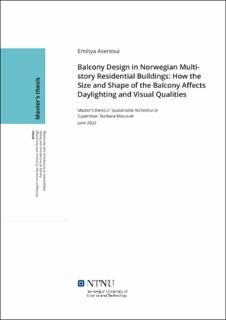| dc.description.abstract | Å inkludere en balkong i en bolig gir flere forbedringer til velværet for beboerne, som for eksempel økt utsiktutnyttelse og forbedret ventilasjon, i tillegg til arkitektoniske verdier slik som å gi et privat uterom. På den andre siden kan en balkong fungere som et overheng som reduserer dagslys og sollys gjennom solskygging, og bidra til økt energibruk ved å øke varmetapet i kalde klimaer.
I denne avhandlingen har forskjellige design for balkonger, der variasjoner i størrelsen (bredde og dybde), type balkong (innfelt/utkraget), og funksjonen til nærliggende rom (kjøkken/stue) til balkongen, og plasseringen av balkongen på bygget, blir optimert for et balkongdesign med fokus dagslysutnyttelse. I tillegg blir det sett på en separat case som innebærer demografisk fortetning i det undersøkte boligområdet. Utsiktsstudier har blitt utført på designvariasjoner i både et scenario for dagens situasjon og det fremtidige fortetningsscenarioet.
Scenarioene ble evaluert basert på effekten av balkongdesignene og nærliggende rom i en etterkrigstidsleilighetsblokk i Trondheim. Denne typen eksperimentering med å redesigne balkonger kan være nyttig i beslutningsprosesser når det gjelder oppussing/renovering av denne typen bygg, som det finnes en signifikant andel av i Norge, og kan også være nyttig i fremtidige fortettingsscenarioer. Til slutt blir innvirkningen av type og størrelse til balkongen på praktisk bruk (skjerming av privatliv og mot elementene) og utsikt diskutert.
All delvis innebygde balkonger ble eliminert. Dette betyr at modellen av dagens situasjon har bedre dagslysindikatorer, og gir også mer fleksibilitet i bruk (beskyttelse mot elementene, visuelt og hørbart privatliv). Et forslag med større, men ikke innebygd, balkong gav bedre daglysindikatorer for alle simulerte leiligheter bortsett fra en endeleilighet på nederste nivå. De beste resultatene kom for versjoner der balkongen var tilknyttet stuen – kun ett forslag der balkongen var tilknyttet kjøkken gav godt resultat i dagslysindikatorer. Utsiktsstudier viste at et sikk-sakk-mønster for plasseringen av balkongene gav forbedringer til utsikten sammenlignet med dersom balkongene var plassert direkte over hverandre. | |
| dc.description.abstract | The provision of a balcony to a residential unit offers several impacts on the well-being of occupants, including improved view enjoyment, and enhanced ventilation, as well as architectural values such as providing a private outdoor space. On the other hand, a balcony can act as an overhang, reducing daylight and sunlight through solar shading, and contributing to energy loss by increasing the heating load in cold climates.
In this thesis, different design proposals for balconies, are created with changes in size (in depth and width), typology (recessed/cantilevered), adjacent room function (kitchen/living room) of the balcony, and the placement of the balcony in connection to the building layout, are considered pursuing optimization of balcony design with a focus on daylight utilization. In addition, a separate case looking at a demographically densified future scenario of the residential development is investigated. View studies are done on design variations of balconies in the current and future scenarios.
This study provides a methodology for optimizing a range of balcony design variables for the objectives of daylighting and view. Accordingly, the daylighting indicators used are Spatial Daylight Autonomy (sDA), Annual Sunlight Exposure (ASE), and Mean Illuminance (Avg Lux). The view indicator is the number of layers of the view. The daylight performance is investigated with the use of the typical weather data set of a Continental Subarctic Climate city (Dfc), Trondheim, in Norway.
All the partly recessed balconies were eliminated. This means that the current situation model has the best daylighting indicator values, while also providing flexibility in use (partly sheltered, partly exposed to climatic conditions, providing visual and audible privacy). An interesting aspect of Proposal 4 is that, while it is better for most apartments, for the lower end apartment it is worse than the current situation model, due to lower direct sunlight access and annual mean illuminance. All daylighting indicator values are highest when the balcony is attached to the living room. The scenarios where the balcony is attached to the kitchen for the end apartment is only Proposal 2, which is in the minimum recommended depth of balcony. View studies showed that staggering the placement of balconies between levels gives significant improvements to view compared to placement of balconies directly above or below each other. | |
